Analysis of Land-Use Spatial Equilibrium in the Yangtze River Economic Belt Under the Context of High-Quality Development: Quantity Balance and Efficiency Coordination
Abstract
1. Introduction
2. Materials and Methods
2.1. Theoretical Mechanism Analysis
2.2. Research Framework
2.3. Study Area and Data Sources
2.3.1. Research Area
2.3.2. Data Sources
2.4. Construction of Evaluation Indicator System
2.5. Research Methods
2.5.1. Measurement Model of Land-Use Spatial Balance
- (1)
- Land Demand Intensity and Land Supply Capacity
- (2)
- Land-Use Supply–Demand Balance Index
- (3)
- Land-Use Supply–Demand Efficiency Index
- (4)
- Land-Use Spatial Balance
2.5.2. Three-Dimensional Kernel Density Estimation
2.5.3. Moran’s Index
- (1)
- Global Moran’s Index
- (2)
- Local Moran’s Index
3. Results
3.1. Temporal Evolution of Land-Use Spatial Equilibrium Degrees in the YREB
3.2. Spatial Evolution Characteristics of Land-Use Spatial Equilibrium Degrees in the YREB
3.3. Spatial Clustering Characteristics of Land-Use Spatial Equilibrium Degrees in the YREB
4. Classification of Land-Use Spatial Equilibrium Types and Analysis of Differentiated Development Paths
5. Discussion and Conclusions
5.1. Discussion
5.2. Conclusions
Author Contributions
Funding
Data Availability Statement
Acknowledgments
Conflicts of Interest
References
- Cegielska, K.; Rozycka-Czas, R.; Gorzelany, J.; Olczak, B. Land use and land cover conflict risk assessment model: Social and spatial impact of suburbanisation. Landsc. Urban Plan. 2025, 257, 105302. [Google Scholar] [CrossRef]
- Liu, H.X.; Soares-Filho, B.S.; Leite-Filho, A.T.; Zhang, S.H.; Du, J.Z.; Yi, Y.J. How to balance land demand conflicts to guarantee sustainable land development. iScience 2023, 26, 106641. [Google Scholar] [CrossRef] [PubMed]
- Li, X.; Fu, J.Y.; Jiang, D.; Lin, G.; Cao, C.L. Land use optimization in Ningbo City with a coupled GA and PLUS model. J. Clean. Prod. 2022, 375, 134004. [Google Scholar] [CrossRef]
- Jiang, Z.M.; Wu, H.; Lin, A.Q.; Shariff, A.R.M.; Hu, Q.; Song, D.X.; Zhu, W.C. Optimizing the spatial pattern of land use in a prominent grain-producing area: A sustainable development perspective. Sci. Total Environ. 2022, 843, 156971. [Google Scholar] [CrossRef] [PubMed]
- Jing, X.D.; Tian, G.L.; He, Y.C.; Wang, M.R. Spatial and temporal differentiation and coupling analysis of land use change and ecosystem service value in Jiangsu Province. Ecol. Indic. 2024, 163, 112076. [Google Scholar] [CrossRef]
- Deng, C.X.; Liu, J.Y.; Liu, Y.J.; Li, Z.W.; Nie, X.D.; Hu, X.Q.; Wang, L.X.; Zhang, Y.T.; Zhang, G.Y.; Zhu, D.M.; et al. Spatiotemporal dislocation of urbanization and ecological construction increased the ecosystem service supply and demand imbalance. J. Environ. Manag. 2021, 288, 112478. [Google Scholar] [CrossRef]
- Tan, S.K.; Liu, Q.; Li, Y.N. Spatial-temporal characteristics of spatial balance degrees on land use in China. China Land Sci. 2017, 31, 40–46. [Google Scholar]
- Qu, Y.B.; Dong, X.Z.; Su, D.S.; Jiang, G.H.; Ma, W.Q. How to balance protection and development? A comprehensive analysis framework for territorial space utilization scale, function and pattern. J. Environ. Manag. 2023, 339, 117809. [Google Scholar] [CrossRef]
- Sadian, A.; Shafizadeh-Moghadam, H. The future of agricultural lands under the combined influence of shared socioeconomic pathways and urban expansion by 2050. Agric. Syst. 2025, 224, 104234. [Google Scholar] [CrossRef]
- Franco-Solís, A.; Montania, C.V. Dynamics of deforestation worldwide: A structural decomposition analysis of agricultural land use in South America. Land Use Policy 2021, 109, 105619. [Google Scholar] [CrossRef]
- Huang, J.C.; Wang, S.; Wang, Y.H. Evaluation of land use space equilibrium degree from perspective of supply and demand driven in Henan Province. Resour. Dev. Mark. 2018, 34, 35–40. [Google Scholar]
- Zhou, Y.; Zhong, Z.; Cheng, G.Q. Cultivated land loss and construction land expansion in China: Evidence from national land surveys in 1996, 2009 and 2019. Land Use Policy 2023, 125, 106496. [Google Scholar] [CrossRef]
- Liu, X.Z.; Li, X.S.; Zhang, Y.H.; Wang, Y.X.; Chen, J.Q.; Geng, Y.W. Spatiotemporal evolution and relationship between construction land expansion and territorial space conflicts at the county level in Jiangsu Province. Ecol. Indic. 2023, 154, 110662. [Google Scholar] [CrossRef]
- Ren, Y.F.; He, X.N.; Jiang, Q.N.; Zhang, F.; Zhang, B.T. Advancing high-quality development in China: Unraveling the dynamics, disparities, and determinants of inclusive green growth at the prefecture level. Ecol. Indic. 2024, 169, 112898. [Google Scholar] [CrossRef]
- Fu, J.Y.; Bu, Z.Q.; Jiang, D.; Lin, G.; Li, X. Sustainable land use diagnosis based on the perspective of production-living-ecological spaces in China. Land Use Policy 2022, 122, 106386. [Google Scholar] [CrossRef]
- Dagum, C. A new approach to the decomposition of the Gini income inequality ratio. Empir. Econ. 1997, 22, 515–531. [Google Scholar] [CrossRef]
- Zhou, R.X.; Jin, J.L.; Cui, Y.; Ning, S.W.; Zhou, L.G.; Zhang, L.B.; Wu, C.G.; Zhou, Y.L. Spatial equilibrium evaluation of regional water resources carrying capacity based on dynamic weight method and Dagum Gini coefficient. Front. Earth Sci. 2022, 9, 790349. [Google Scholar] [CrossRef]
- Jiang, Y.Q.; Shi, C.M. Estimating sustainability and regional inequalities using an enhanced sustainable development index in China. Sustain. Cities Soc. 2023, 99, 104555. [Google Scholar] [CrossRef]
- Ma, A.H.; Gao, Y.J.; Zhao, W.M. Research on territorial spatial development non-equilibrium and temporal-spatial patterns from a conjugate perspective: Evidence from Chinese provincial panel data. Land 2024, 13, 797. [Google Scholar] [CrossRef]
- Shen, H.Y.; Teng, F.; Song, J.P. Evaluation of spatial balance of China’s regional development. Sustainability 2018, 10, 3314. [Google Scholar] [CrossRef]
- Han, M.Y.; Chen, G.Q.; Dunford, M. Land use balance for urban economy: A multi-scale and multi-type perspective. Land Use Policy 2019, 83, 323–333. [Google Scholar] [CrossRef]
- Li, X.; Lv, X.; Yin, R.M.; Fang, B.; Jin, T. Spatial equilibrium state and its time evolution of the multi-functionalization of regional land use in the Eastern China. Pol. J. Environ. Stud. 2021, 30, 2827–2841. [Google Scholar] [CrossRef]
- Zhu, R.M.; Chen, S.L. Research on spatial-temporal characteristics and driving forces of spatial balance degrees on land use in Fujian Province. J. Shanxi Normal Univ. (Nat. Sci. Ed.) 2021, 35, 96–105. [Google Scholar]
- Ma, Q.; Shi, F.F. New urbanization and high-quality urban and rural development: Based on the interactive coupling analysis of industrial green transformation. Ecol. Indic. 2023, 156, 111044. [Google Scholar] [CrossRef]
- Gao, Q.; Fang, C.L.; Liu, H.M.; Zhang, L.F. Conjugate evaluation of sustainable carrying capacity of urban agglomeration and multi-scenario policy regulation. Sci. Total Environ. 2021, 785, 147373. [Google Scholar] [CrossRef] [PubMed]
- De Bonis, M.V.; Ruocco, G. A generalized conjugate model for forced convection drying based on an evaporative kinetics. J. Food Eng. 2008, 89, 232–240. [Google Scholar] [CrossRef]
- Selvamurugan, R.; Pathan, B.M.; Hanchinal, A.N.; Dhar, A. Geomagnetic pulsation over conjugate locations during geomagnetic storms and substorm. Adv. Space Res. 2011, 48, 1591–1599. [Google Scholar] [CrossRef]
- Hong, H.K.; Cai, Z.C.; Liao, H.P.; Wang, G.; Liu, T. Housing-employment coordinated development and rural revitalization path at the county level in Chongqing Municipality: From the conjugate perspective. Prog. Geogr. 2023, 42, 1098–1111. [Google Scholar] [CrossRef]
- Yu, G.M.; Li, M.X.; Tu, Z.F.; Yu, Q.W.; Jie, Y.; Xu, L.L.; Dang, Y.F.; Chen, X.X. Conjugated evolution of regional social-ecological system driven by land use and land cover change. Ecol. Indic. 2018, 89, 213–226. [Google Scholar] [CrossRef]
- Bandurski, K.; Kwedlo, W. A Lamarckian hybrid of differential evolution and conjugate gradients for neural network training. Neural Process. Lett. 2010, 32, 31–44. [Google Scholar] [CrossRef]
- Xie, Z.Y.; He, L.J.; Mao, Z.; Wan, W.; Song, X.; Wu, Z.J.; Liang, H.; Liu, J.; Zheng, B.F.; Zhu, J.Q. Spatial heterogeneity of natural and socio-economic features shape that of ecosystem services. A large-scale study on the Yangtze River Economic Belt, China. Ecol. Indic. 2024, 159, 111729. [Google Scholar] [CrossRef]
- Li, J.C.; Zhang, X.Y.; Kahil, T.; Chen, D.N.; Wang, G.Y.; Xu, S.S.; Zhang, Y.; Chen, Y. From regional imbalances to latecomer advantage: Phosphorus pollution and economic development in the Yangtze economic belt. Ecol. Indic. 2025, 173, 113423. [Google Scholar] [CrossRef]
- Liu, Q.; Su, Z.Z.; Huang, W.H. Analysis of the influencing factors of the high-quality utilization of territorial space based on the perspective of spatial equilibrium: A case study of Hunan Province, China. Sustainability 2022, 14, 12818. [Google Scholar] [CrossRef]
- Zhang, J.K.; Hou, Y.Z.; Liu, P.L.; He, J.W.; Zhuo, X. The objectives, requirements, and strategic pathways of high-quality development. J. Manag. World 2019, 35, 1–7. [Google Scholar]
- Li, Z.Y.; Luan, W.X.; Zhang, Z.C.; Su, M. Relationship between urban construction land expansion and population/economic growth in Liaoning Province, China. Land Use Policy 2020, 99, 105022. [Google Scholar] [CrossRef]
- Guo, Z.L.; Hu, Y.C.; Wang, J.; Bai, Y.P. Has China completed the supply-side structural reform of construction land supply? Evidence from 335 cities. Habitat Int. 2025, 156, 103271. [Google Scholar] [CrossRef]
- Xiang, A.; Ye, X.; Chuai, X.W.; Cai, Y.Y.; Wang, T.; Luo, Y.T. Heterogeneity analysis of food supply-demand patterns and land carbon loss under different dietary structures in China. Land Use Policy 2024, 145, 107290. [Google Scholar] [CrossRef]
- Bole, Y.; Rina, S.; Guga, S.; Na, M.; Fan, S.M.; Zhang, J.Q. Evaluation of resources, environment, and ecological carrying capacity from the perspective of “production-living-ecology” spaces: A case study of western Jilin Province, China. J. Clean. Prod. 2025, 491, 144770. [Google Scholar] [CrossRef]
- Wang, S.L.; Yang, L.P.; Arif, M. Evolutionary analysis of ecological-production-living space-carrying capacity in tourism-centric traditional villages in Guangxi, China. J. Environ. Manag. 2025, 375, 124182. [Google Scholar] [CrossRef]
- Li, X.; Xu, X.; Yin, R.M. Spatial optimization of agricultural production from the perspective of “Greater Food Concept” in Yangzhou, China. Ecol. Indic. 2024, 169, 112805. [Google Scholar] [CrossRef]
- Zhu, X.N.; Liu, Y.Z.; Wang, Y.; Chen, Y.; Zhang, Z.; Song, G.F. Response mechanism of ecosystem service function to urban land expansion process in Wuhan. Resour. Environ. Yangtze Basin 2020, 29, 1515–1524. [Google Scholar]
- Xie, G.D.; Lu, C.X.; Leng, Y.F.; Zheng, D.; Li, S.C. Ecological assets valuation of the Tibetan Plateau. J. Nat. Resour. 2003, 18, 189–196. [Google Scholar]
- Peng, S.Y.; Yu, Y.J. Green development efficiency measurement and influencing factors analysis in the Yangtze River Economic Belt, China. Ecol. Indic. 2024, 162, 112025. [Google Scholar] [CrossRef]
- Wang, C.Q.; Ibrahim, H.; Wu, F.H.; Chang, W.T. Spatial and temporal evolution patterns and spatial spillover effects of carbon emissions in China in the context of digital economy. J. Environ. Manag. 2025, 373, 123811. [Google Scholar] [CrossRef] [PubMed]
- Anselin, L. Local indicators of spatial association—LISA. Geogr. Anal. 1995, 27, 93–115. [Google Scholar] [CrossRef]
- Li, Y.H.; You, X.; Sun, X.Y.; Chen, J. Dynamic assessment and pathway optimization of agricultural modernization in China under the sustainability framework: An empirical study based on dynamic QCA analysis. J. Clean. Prod. 2024, 479, 144072. [Google Scholar] [CrossRef]
- Lu, C.; She, J.J.; Pan, H.Z.; Zhou, X.L.; Zhou, S.T.; Guo, Z.H. Spatiotemporal dynamics of urban–rural integration and resilience: A multi-layer network study in the Chengdu–Chongqing urban agglomeration. Environ. Sustain. Indic. 2025, 27, 100800. [Google Scholar] [CrossRef]
- Wei, S.M.; Pan, J.H. Spatiotemporal characteristics of residents’ intercity travel in China under the impact of COVID-19 pandemic. Cities 2024, 152, 105206. [Google Scholar] [CrossRef]
- Xu, A.D.; Qian, F.B.; Pai, C.H.; Yu, N.; Zhou, P. The impact of COVID-19 epidemic on the development of the digital economy of China: Based on the data of 31 provinces in China. Front. Public Health 2022, 9, 778671. [Google Scholar] [CrossRef]
- Martinho, V.J.P.D. Impacts of the COVID-19 pandemic and the Russia–Ukraine conflict on land use across the world. Land 2022, 11, 1614. [Google Scholar] [CrossRef]
- Hepburn, C.; Qi, Y.; Stern, N.; Ward, B.; Xie, C.P.; Zenghelis, D. Towards carbon neutrality and China’s 14th Five-Year Plan: Clean energy transition, sustainable urban development, and investment priorities. Environ. Sci. Ecotechnol. 2021, 8, 100130. [Google Scholar] [CrossRef]
- Li, J.F.; Gu, A.L.; Ma, Z.Y.; Zhang, C.L.; Sun, Z.Q. Economic development, energy demand, and carbon emission prospects of China’s provinces during the 14th Five-Year Plan period: Application of CMRCGE model. Adv. Clim. Change Res. 2019, 10, 165–173. [Google Scholar] [CrossRef]
- Zhang, Z.Y.; Zhang, L.J.; Liang, T.; Cheng, L.; Fang, L.H.; Zhao, B.; Zhang, J.Y.; Wen, C.H. Has the Yangtze River Economic Belt strategy promoted the construction of ecological civilization in the upper reaches of the Yangtze River? Front. Environ. Sci. 2022, 10, 1046323. [Google Scholar] [CrossRef]
- Zhao, W.; Jiang, C.J. Analysis of the spatial and temporal characteristics and dynamic effects of urban-rural integration development in the Yangtze River Delta Region. Land 2022, 11, 1054. [Google Scholar] [CrossRef]
- Huang, L.J.; Yang, P.; Zhang, B.Q.; Hu, W.Y. Spatio-temporal coupling characteristics and the driving mechanism of population-land-industry urbanization in the Yangtze River Economic Belt. Land 2021, 10, 400. [Google Scholar] [CrossRef]
- Fan, J. High-quality development of national territory space governance and regional economic layout during 14th Five-Year Plan in China. Bull. Chin. Acad. Sci. (Chin. Ver.) 2020, 35, 796–805. [Google Scholar]
- Bian, F.M.; Liu, Y.T.; Zhao, L. The spatial balance degree evaluation on land use in Jilin Province. China Land Sci. 2015, 29, 74–80. [Google Scholar]
- Yang, Q.K.; Wang, L.; Li, Y.L.; Qin, X.H. Land use spatial equilibrium from the perspective of supply and demand matching: A case study of Jiangsu Province. Resour. Sci. 2021, 43, 932–943. [Google Scholar] [CrossRef]
- Rey, S.J.; Murray, A.T.; Anselin, L. Visualizing regional income distribution dynamics. Lett. Spat. Resour. Sci. 2011, 4, 81–90. [Google Scholar] [CrossRef]
- Louw, E.; van der Krabben, E.; Priemus, H. Spatial development policy: Changing roles for local and regional authorities in the Netherlands. Land Use Policy 2003, 20, 357–366. [Google Scholar] [CrossRef]
- Downs, A. Smart growth: Why we discuss it more than we do it. J. Am. Plan. Assoc. 2005, 71, 367–378. [Google Scholar] [CrossRef]
- Feng, Y.C.; Sun, M.M.; Pan, Y.X.; Zhang, C. Fostering inclusive green growth in China: Identifying the impact of the regional integration strategy of Yangtze River Economic Belt. J. Environ. Manag. 2024, 358, 120952. [Google Scholar] [CrossRef]

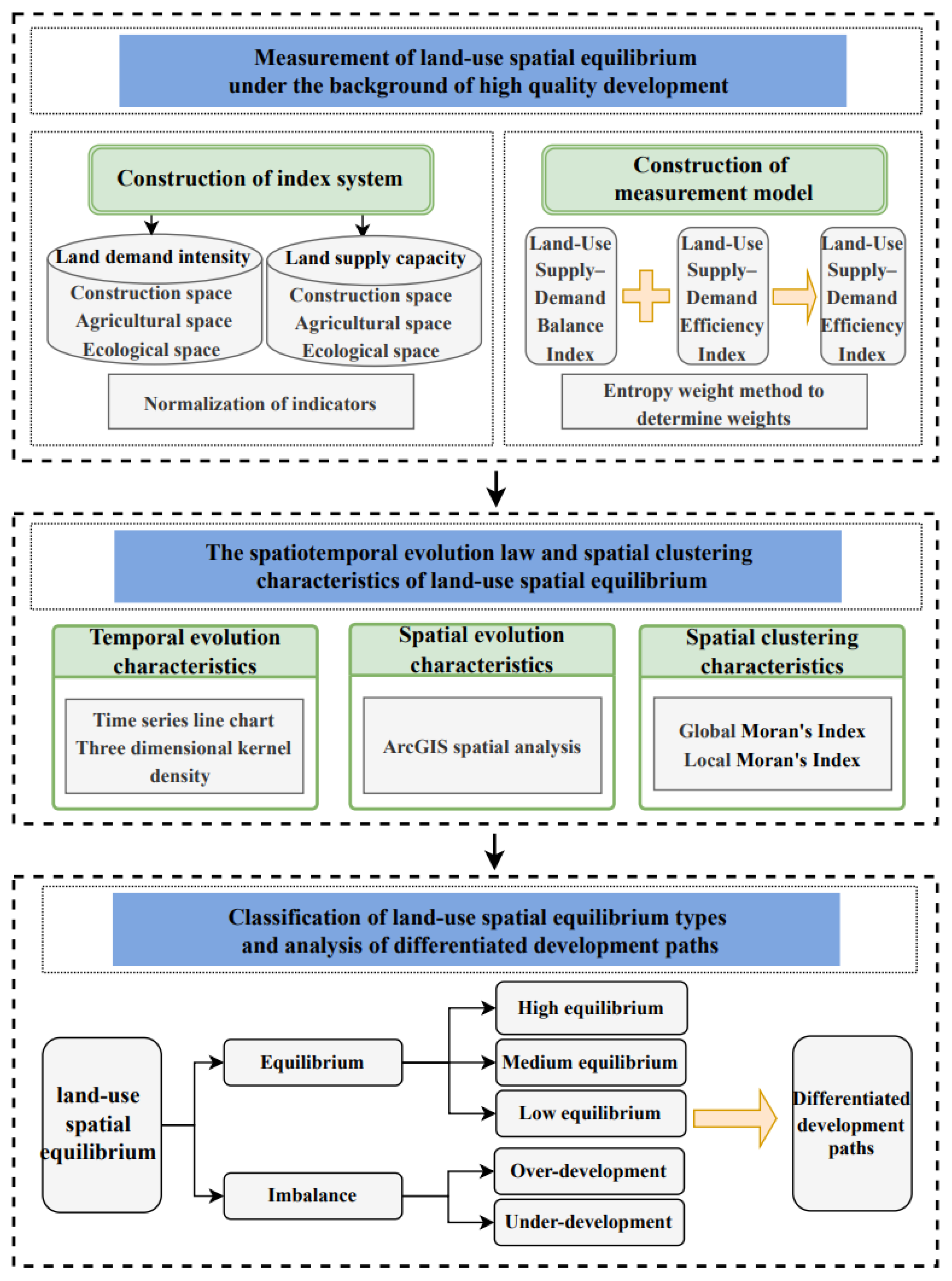

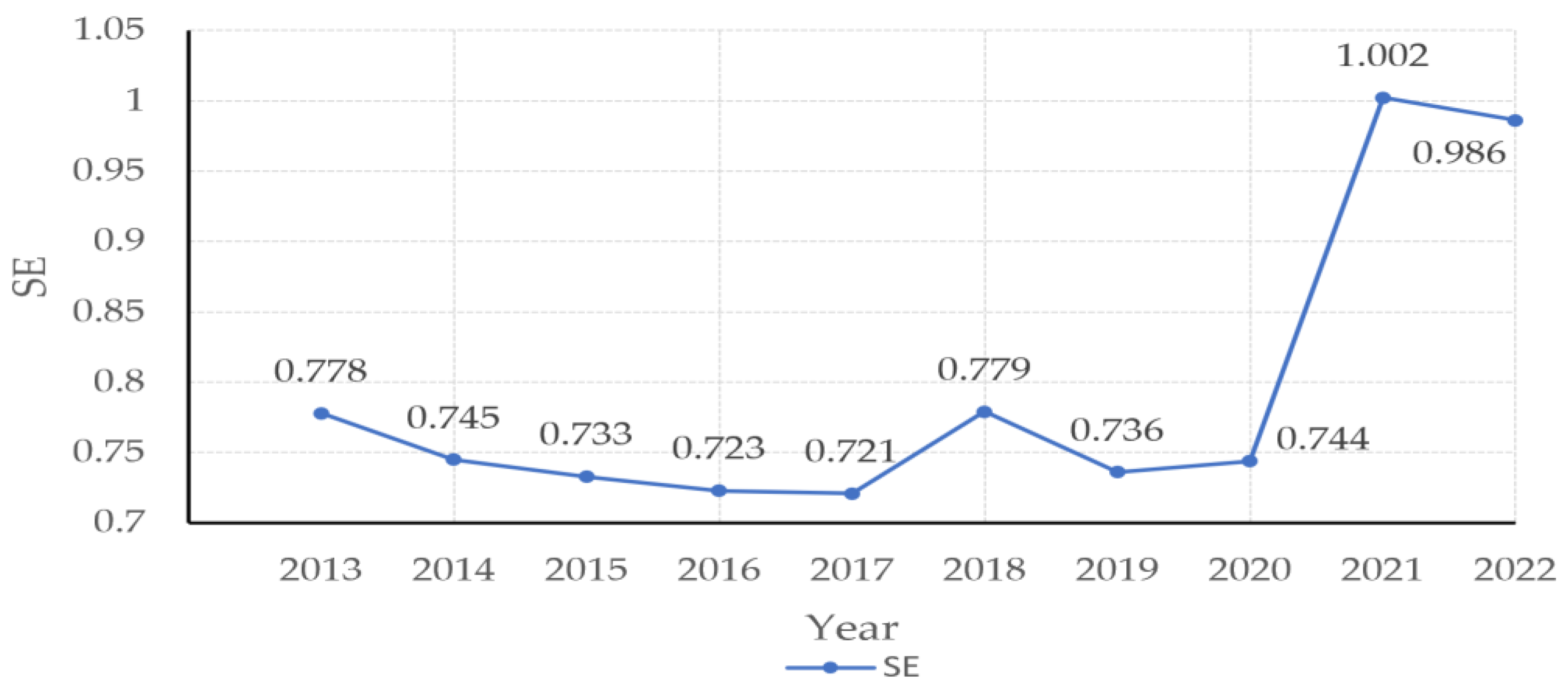
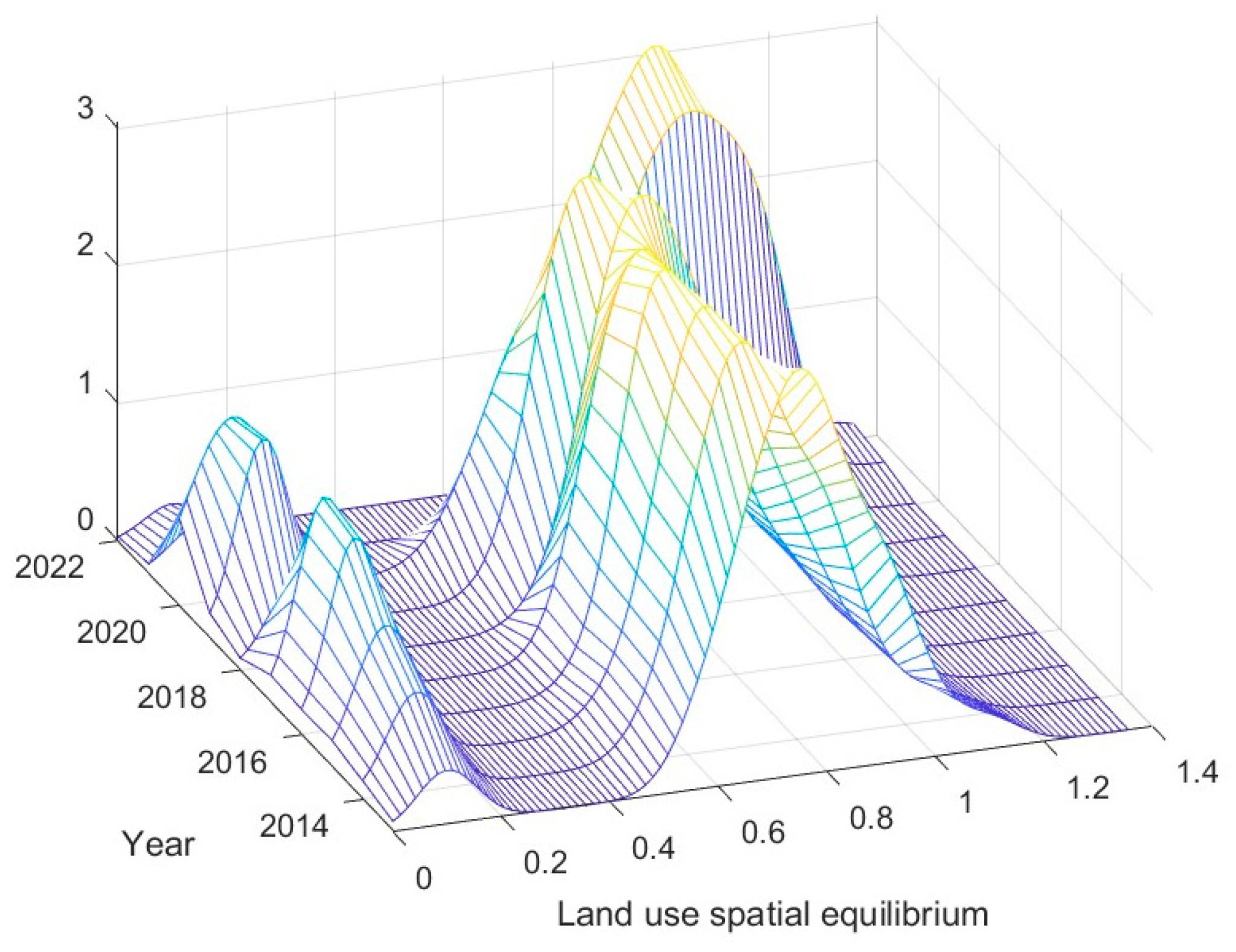
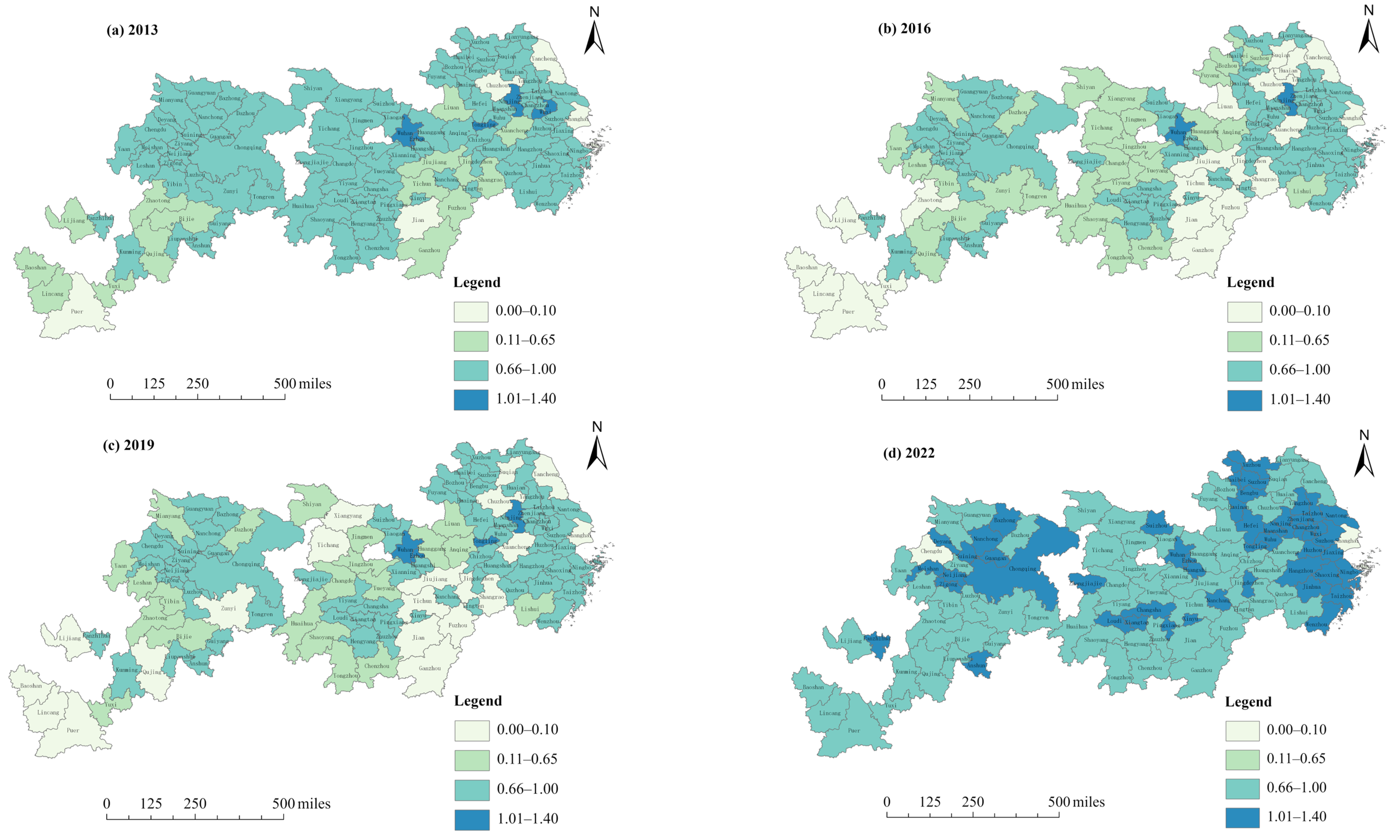

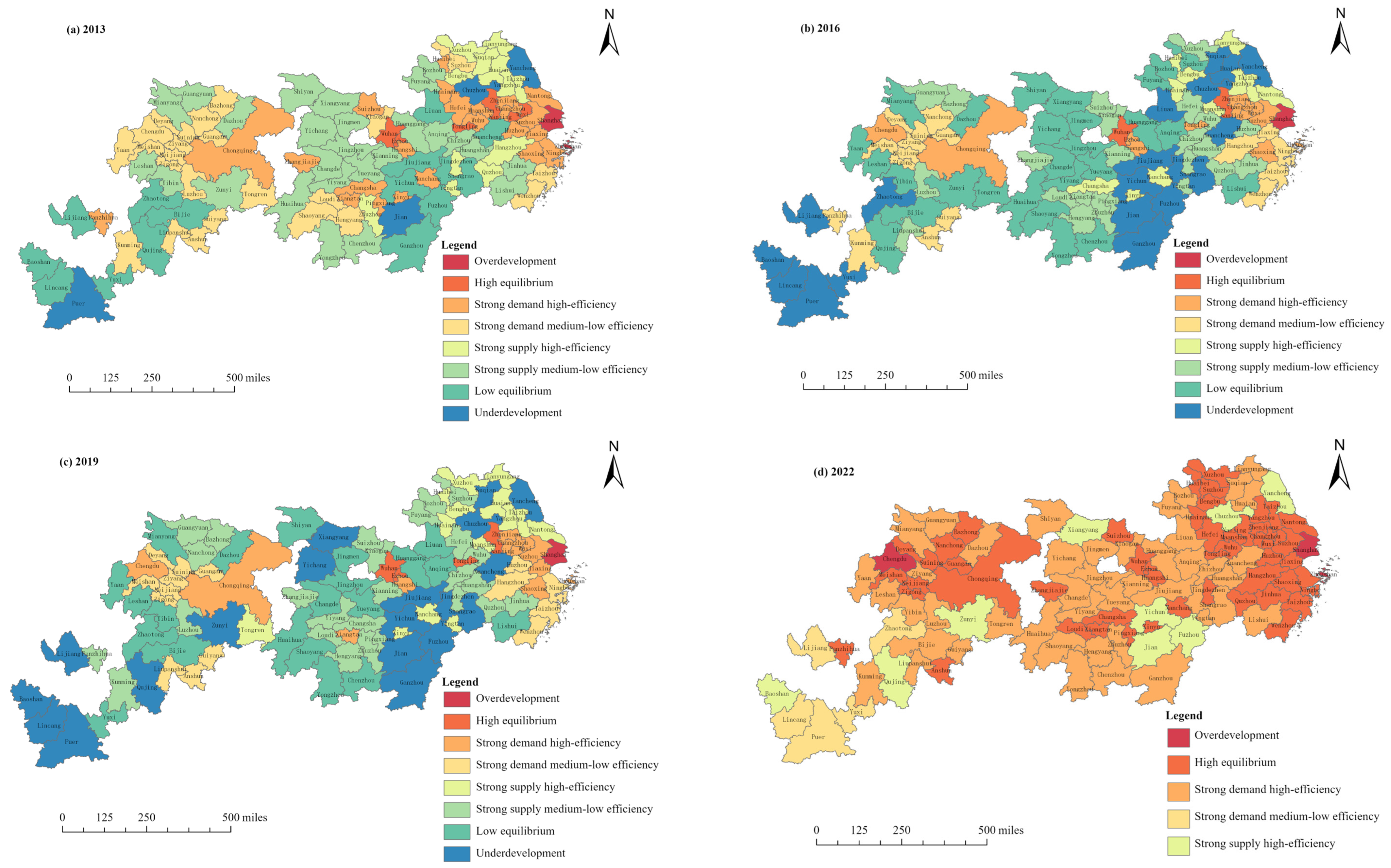
| Target Level | Criterion Level | Indicator Level | Indicator Definition | Calculation Method |
|---|---|---|---|---|
| Land demand intensity (LD) | Construction space demand | Population density (persons/km2) | Represents residential land demand | Resident population/total land area |
| GDP per unit of land area (104 CNY/km2) | Represents industrial land demand | Regional GDP/total land area | ||
| Agricultural space demand | Per capita grain consumption (kg) | Represents agricultural space demand due to human grain consumption | (urban per capita grain consumption × urban population ratio) + (rural per capita grain consumption × rural population ratio) | |
| Per capita meat consumption (kg) | Represents agricultural space demand due to human meat consumption | Meat consumption/resident population | ||
| Ecological space demand | Carbon emission per GDP (t/108 CNY) | Represents ecological space demand due to production and living carbon emissions | Carbon emissions/regional GDP | |
| Per capita water supply (m3) | Represents ecological space demand due to production and living water consumption | Regional water supply/resident population | ||
| Land supply capacity (LS) | Construction space supply | Per capita construction land area (km2/104 persons) | Represents quantity of construction space supply | Construction land area/resident population |
| Unit construction land output (108 CNY/km2) | Represents quality of construction space supply | Added value of secondary and tertiary industries/construction land area | ||
| Agricultural space supply | Per capita arable land area (km2/104 persons) | Represents quantity of agricultural space supply | Arable land area/resident population | |
| Unit area grain yield (t/km2) | Represents quality of agricultural space supply | Total grain yield/arable land area | ||
| Ecological space supply | Forest coverage rate (%) | Represents quantity of ecological space supply | Forest area/total land area | |
| Per capita ecological service value | Represents quality of ecological space supply | Ecological service value/ecological land area |
| Year | Moran’s I | p-Value | Z-Value |
|---|---|---|---|
| 2013 | 0.174 | 0.012 | 2.499 |
| 2014 | 0.195 | 0.005 | 2.760 |
| 2015 | 0.174 | 0.013 | 2.466 |
| 2016 | 0.210 | 0.003 | 2.933 |
| 2017 | 0.151 | 0.032 | 2.147 |
| 2018 | 0.182 | 0.009 | 2.609 |
| 2019 | 0.154 | 0.028 | 2.191 |
| 2020 | 0.168 | 0.004 | 2.880 |
| 2021 | 0.022 | 0.657 | 0.443 |
| 2022 | 0.068 | 0.272 | 1.096 |
| Status | Land-Use Spatial Equilibrium Degree | Classification Criteria |
|---|---|---|
| Imbalance | Overdevelopment | BI ∈ [1.40, 2.20) |
| Underdevelopment | BI ∈ (0, 0.40] | |
| Equilibrium | High equilibrium | ∈ [1.00, 1.40) |
| Medium equilibrium | Strong-demand, high-efficiency: ∈ (0.65, 1.00), BI ∈ [0.60, 1.40) and EI ∈ [1.00, 1.50) | |
| Strong-demand, medium–low-efficiency: ∈ (0.65, 1.00), BI ∈ [0.60, 1.40) and EI ∈ (0.65, 1.00) | ||
| Strong-supply, high-efficiency: ∈ (0.65, 1.00), BI ∈ (0.40, 0.60) and EI ∈ [1.00, 1.50) | ||
| Strong-supply, medium–low-efficiency: ∈ (0.65, 1.00), BI ∈ (0.40, 0.60) and EI ∈ (0.65, 1.00) | ||
| Low equilibrium | ∈ (0, 0.65] |
Disclaimer/Publisher’s Note: The statements, opinions and data contained in all publications are solely those of the individual author(s) and contributor(s) and not of MDPI and/or the editor(s). MDPI and/or the editor(s) disclaim responsibility for any injury to people or property resulting from any ideas, methods, instructions or products referred to in the content. |
© 2025 by the authors. Published by MDPI on behalf of the International Society for Photogrammetry and Remote Sensing. Licensee MDPI, Basel, Switzerland. This article is an open access article distributed under the terms and conditions of the Creative Commons Attribution (CC BY) license (https://creativecommons.org/licenses/by/4.0/).
Share and Cite
Ma, A.; Zhao, W.; Gao, Y. Analysis of Land-Use Spatial Equilibrium in the Yangtze River Economic Belt Under the Context of High-Quality Development: Quantity Balance and Efficiency Coordination. ISPRS Int. J. Geo-Inf. 2025, 14, 355. https://doi.org/10.3390/ijgi14090355
Ma A, Zhao W, Gao Y. Analysis of Land-Use Spatial Equilibrium in the Yangtze River Economic Belt Under the Context of High-Quality Development: Quantity Balance and Efficiency Coordination. ISPRS International Journal of Geo-Information. 2025; 14(9):355. https://doi.org/10.3390/ijgi14090355
Chicago/Turabian StyleMa, Aihui, Wanmin Zhao, and Yijia Gao. 2025. "Analysis of Land-Use Spatial Equilibrium in the Yangtze River Economic Belt Under the Context of High-Quality Development: Quantity Balance and Efficiency Coordination" ISPRS International Journal of Geo-Information 14, no. 9: 355. https://doi.org/10.3390/ijgi14090355
APA StyleMa, A., Zhao, W., & Gao, Y. (2025). Analysis of Land-Use Spatial Equilibrium in the Yangtze River Economic Belt Under the Context of High-Quality Development: Quantity Balance and Efficiency Coordination. ISPRS International Journal of Geo-Information, 14(9), 355. https://doi.org/10.3390/ijgi14090355










